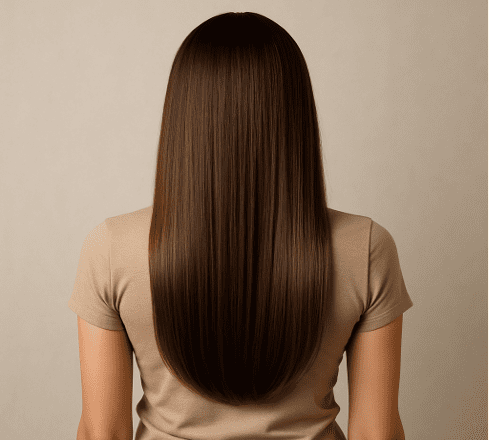Is your hair feeling dry, frizzy, or breaking more than usual? You’re not alone. Styling tools (blow dryers, flat irons, or curling irons) and extreme weather , UV rays, or pollution damage your hair and remove essential vitamins and minerals from your healthy hair. The good news? You don’t need to go to the salon for treatment of your dry and frizzy hair.
In this article, we’ll show you exactly how to repair damaged hair at home using simple tips, natural remedies, and the right hair care habits. Whether your hair is suffering from split ends, dullness, dryness, or breakage, by using home remedies you can restore shine, strength, and softness without going to the salon.
⦁ What causes hair damage?:
These are some common hair care practices that can damage your hair-
⦁ Wash your hair by rubbing shampoo into the length of your hair.
⦁ Skipping the conditioner.
⦁ Drying your hair by rubbing it with a towel.
⦁ Brushing your hair while it is wet.
⦁ Using a blow dryer, hot comb, or curling iron.
⦁ Pulling your hair back tightly, such as in a ponytail, bun, or cornrows.
⦁ Wearing a weave or hair extensions.
⦁ Coloring, perming, or relaxing your hair.
⦁ Various types of chemical treatment.
⦁ Signs your hair is damage:

Damaged hair looks like a cuticle layer becomes cracked or split in certain areas. If you want to see damaged hair then take a strand of healthy hair and one strand of damaged hair under a microscope then you will find a difference.
The good news? Either you have straight hair, wavy hair, or curly hair, there are a few clear signs of hair damage
1. Your hair feels dry and looks dull.
2. You notice split ends often.
3. Hair breaks easily when brushing or styling.
4. It’s getting harder to detangle your hair.
5. Your hair doesn’t bounce back when you stretch it.
6. You’re seeing more hair fall or thinning areas.
7. Styling your hair is becoming a struggle.
⦁ How to repair damage hair – step by step:

⦁ Start with a trim. Hair breakage, including split or thinning ends, is a very common problem which damages your hair. So, if your hair starts to get damaged ( split or very dry) then trim the worst damage part. Even a small trim makes a big difference and prevents dryness and breakage. ⦁ Oil treatments (1-2 times in a week)If your hair looks and feels very dry and dehydrated then use oils to deeply nourish, strengthen, and add shine to your hair.Different oils have different work for hair; Hair Issue Best OilsDry/Damaged Coconut oil, Olive oil, Avocado oilFrizz/Breakage Argan oil, Sweet almond oilDandruff/Itchy Scalp Tea tree oil (diluted), Jojoba oilHair Growth Castor oil, Rosemary oil (diluted), Peppermint oil (diluted)Fine HairGrapeseed oil, Jojoba oil (lighter oils) How to use; Warm up a few tablespoons (by double boiling process), apply to dry hair, especially the ends. Leave on for 30 min to overnight, then wash out. For better results you can also mix 2 oils.
3. DIY hair masks (1 times in a week)
If your hair looks and feels very dry and dehydrated then use oils to deeply nourish, strengthen, and add shine to your hair.
Different oils have different work for hair;

How to use;
Warm up a few tablespoons (by double boiling process), apply to dry hair, especially the ends. Leave on for 30 min to overnight, then wash out. For better results you can also mix 2 oils.
3. DIY hair masks (1 times in a week)
DIY hair masks are very useful for repairing hair from damages and increase hydration, reduce frizz, and improve scalp health. Hair masks are the cheapest way to provide hydration, softening, adding shine, and even fighting off infections because salon treatments are very expensive , they may also not be sure about your result and use very harsh chemical products which may cause hair damage in future.
There are some list of DIY hair mask


4. Use a sulfate free shampoo and hydrating conditioners
Sulfates are mainly strong detergents. Nowadays, it is found in many shampoo as a cleansing agent. They create lots of foam after application, But they can also be harsh on your hair.
Sulfates shampoo strips natural oils from your hair and scalp and can cause dryness, frizzness, and roughness. So, always use sulfates free shampoo because they are gentle in your hair and provide smoothness, nourishment, and protect your scalp from dryness.
After shampoo always apply sulfate free conditioner because it provides extra hydration in your hair and makes it smooth, shiny and protects from split hair or dryness.
5. Rinse with cool water
After applying shampoo and conditioning your hair, wash your hair with cold water because hot water makes your hair harsh, rough, and removes natural shine into your hair.
Benefits of rinsing with cold water:
⦁ Seals the hair cuticles.
⦁ Reduce frizz.
⦁ Add natural shine.
⦁ Prevents breakage.
⦁ Soothes the scalp.
6. Avoid heat styling (as much as possible)
Heat styling tools(hair dryer,strengthening,curler etc…) are high in temperature. So, the use of these tools can cause cuticle damage, protein denaturation, thermal fatigue, and dehydration in the hair shaft.
Instead of heat styling tools, use heatless hair styling tools like heatless curlers, hair rollers, hair clips etc…… They style your hair without affecting your hair.
And by chance if you are using heat styling tools then use a heat protection serum before style your hair which protects your hair from the heat.
7. Sleep smart
Sleeping smart means protecting your hair while you sleep to prevent breakage, frizz, and dryness. This includes using a silk or satin pillowcase, tying hair loosely (like in a braid or bun), and avoiding friction from rough fabrics. It is very helpful for maintaining your hair moisture, providing hydration, and preventing hair breakage.
CONCLUSION
Repairing damaged hair at home is not only possible—it’s simple with the right care, habits, and natural remedies. By understanding the causes of hair damage and recognizing the signs early, you can take steps to restore your hair’s health. Start with small changes like regular trims, nourishing oil treatments, and weekly DIY masks. Switch to gentle, sulfate-free shampoos and always condition your hair. Avoid heat styling as much as possible, rinse with cool water, and protect your hair while sleeping. With consistency and patience, your hair can regain its strength, shine, and softness—no salon required

